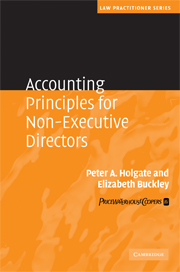Book contents
- Frontmatter
- Contents
- Acknowledgements
- Which standards and legislation has this book been based on?
- Glossary of terms
- Part I The accounting environment
- Part II Some specifics
- 8 Individual entity and consolidated financial statements
- 9 Presentation of financial statements
- 10 Earnings per share
- 11 Mergers and acquisitions
- 12 Interaction of accounting with tax
- 13 Assets
- 14 Liabilities
- 15 Leases
- 16 Pensions
- 17 Financial instruments
- 18 Share-based payment
- 19 Realised and distributable profits
- 20 Disclosures in published annual reports
- Appendices
- Index
9 - Presentation of financial statements
from Part II - Some specifics
Published online by Cambridge University Press: 02 November 2009
- Frontmatter
- Contents
- Acknowledgements
- Which standards and legislation has this book been based on?
- Glossary of terms
- Part I The accounting environment
- Part II Some specifics
- 8 Individual entity and consolidated financial statements
- 9 Presentation of financial statements
- 10 Earnings per share
- 11 Mergers and acquisitions
- 12 Interaction of accounting with tax
- 13 Assets
- 14 Liabilities
- 15 Leases
- 16 Pensions
- 17 Financial instruments
- 18 Share-based payment
- 19 Realised and distributable profits
- 20 Disclosures in published annual reports
- Appendices
- Index
Summary
Introduction
The Companies Act requires the directors to prepare financial statements and various reports each year and to send them to shareholders. The total package, including the full financial statements, rather than summary financial statements, tends to be known as either the ‘Report and Accounts’ (taking this name from the days when the Act required only the directors' report and the annual accounts) or the ‘Annual Report’ (reflecting the fact that the various reports, financial statements and other information together form one report to shareholders). In this chapter we look at the components of the financial statements, or accounts. Other parts of the Report and Accounts, such as the Operating and Financial Review and the Directors' Remuneration Report, are discussed in chapter 20. Some argue that ‘accounts’ refers to the primary statements, while ‘financial statements’ refers to the primary statements together with the notes thereto, but often the two terms are used interchangeably. We use the two terms interchangeably within this book.
IFRSs are intended to be applied worldwide and thus are not developed around any legislation, as each country has its own national legislation, whereas, for example, UK accounting standards were originally developed against the background of British legislation. Accordingly, much of what is outlined in this chapter is laid down by accounting standards, mainly IAS 1, for IFRS accounts, whereas it comes from a mix of accounting standards and legislation for UK GAAP accounts.
- Type
- Chapter
- Information
- Accounting Principles for Non-Executive Directors , pp. 80 - 94Publisher: Cambridge University PressPrint publication year: 2009

